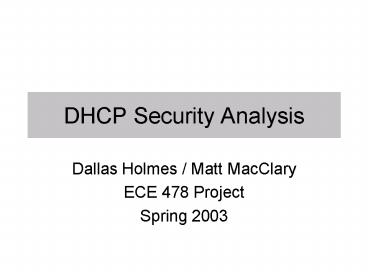DHCP Security Analysis - PowerPoint PPT Presentation
1 / 11
Title:
DHCP Security Analysis
Description:
Discovery based. Any host can respond to query. No server authentication ... Some networks configure network trust (MAC) Client may gain access to network shares ... – PowerPoint PPT presentation
Number of Views:52
Avg rating:3.0/5.0
Title: DHCP Security Analysis
1
DHCP Security Analysis
- Dallas Holmes / Matt MacClary
- ECE 478 Project
- Spring 2003
2
What is DHCP?
- Dynamic Host Configuration Protocol
- UDP protocol for IP
- Discovery Based
- Ratified by the IETF in 1997
- Used on most networks
- OSU utilizes DHCP heavily
3
Why use DHCP?
- Simple host configuration
- Plug and Surf
- Centralized address accounting
- Distribution of vital host information
- Hostname, DNS, WINS, Gateway, etc.
4
3 Significant Problems
- Discovery based
- Any host can respond to query
- No server authentication
- client trusts any server that responds
- 3. No client authentication
- server may assign an address to any client
5
Problem 1 Anybody can answer
- Anybody?
- An attacker could place a rouge server
- Authoritative (legitimate) server.
- Who will the client listen to?
- Logically closest server
- fastest CPU, fastest network, lowest load
- Server with free leases
6
Changing logically closest
- Load the authoritative DHCP server
- Take all the leases away
- Load the network segment
7
How much does it take?
8
Problem 2 Server Authentication
- Client must trust what the server sends
- Server can send fake DNS servers
- client may be shown a misleading resource
- client may be denied access to a resource
- Server can send invalid gateway address
- Attacker could redirect switched traffic
- Loss of privacy
9
Which is Real?
Real Login Screen Fake
Login Screen
10
Problem 3 Host Authentication
- Any client may join network
- Simply plug in and server assigns address
- Some networks configure network trust (MAC)
- Client may gain access to network shares
- Client may abuse network
- Start a rouge DHCP server
- Generate heavy traffic or attack other networks
11
Solution
- SSL Style Public 3rd Party Certificate Authority
- Two-way authentication
- Server Certificate
- Client Certificate
- Requires changes to DHCP server and client
- Slow to implement and gain acceptance
- Expensive
- Certificates cost money
- Changing server configurations costs money































